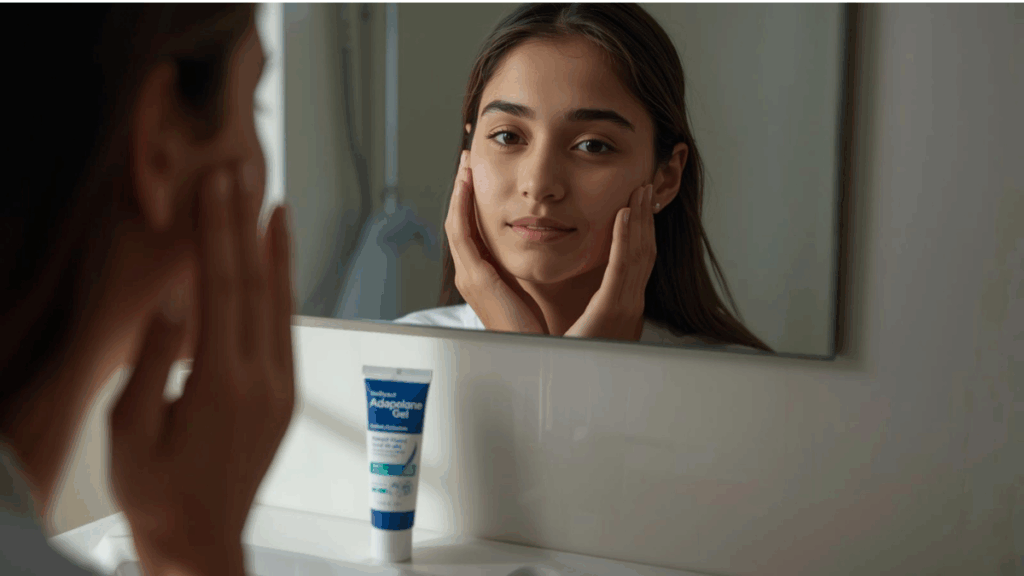Learn everything about Adapalene Gel: its uses in acne treatment, potential side effects, and the right way to apply it for clearer skin.
What is Adapalene Gel?
Adapalene gel is a topical retinoid commonly prescribed for the treatment of acne. It helps reduce inflammation, unclog pores, and promote faster skin cell turnover. Belonging to the same family of drugs as tretinoin and isotretinoin, adapalene is considered safe and effective, often recommended as a first-line treatment for mild to moderate acne.

Adapalene Gel Uses
Adapalene gel is widely used in dermatology, and its primary role is to combat acne. Its applications include:
- Treatment of Acne Vulgaris: Helps manage blackheads, whiteheads, and inflamed pimples.
- Prevents New Breakouts: By regulating skin cell turnover, adapalene helps stop clogged pores, the root cause of acne.
- Reduces Post-Acne Marks: Over time, it can improve skin texture and reduce hyperpigmentation caused by pimples.
- Helps with Oil Control: Regular use may reduce excessive sebum production.
- Combination Therapy: Often used with benzoyl peroxide gel, clindamycin, or salicylic acid face washes for improved results.
How Does Adapalene Work?
Adapalene gel works on a cellular level:
- It speeds up the shedding of dead skin cells.
- Prevents pore blockages that lead to pimples, blackheads, and whiteheads.
- Has anti-inflammatory properties, reducing redness and swelling.
This dual action makes it effective against both comedonal acne (blackheads and whiteheads) and inflammatory acne (red pimples).
Side Effects of Adapalene Gel
Like most retinoids, adapalene may cause irritation, especially when you first start using it. Common side effects include:
- Skin dryness and peeling
- Mild redness and irritation
- Burning or stinging sensation after application
- Increased sensitivity to sunlight
Most side effects are temporary and improve as your skin adjusts. To minimise discomfort, start with applications a few times a week and gradually increase frequency.
How to Apply Adapalene Gel Correctly
Correct application is crucial for achieving the best results and reducing side effects.
Step-by-step guide:
- Cleanse your face: Use a gentle cleanser, preferably one with salicylic acid if recommended by your doctor. Pat dry.
- Apply a pea-sized amount: Use only a thin layer of adapalene gel. Applying more will not speed up results and can increase irritation.
- Target affected areas: Spread evenly over the entire acne-prone area (not just active pimples).
- Moisturise: Follow with a non-comedogenic moisturiser to prevent dryness.
- Use at night: Apply once daily at bedtime, as retinoids make your skin sensitive to sunlight.
- Daytime care: Always apply sunscreen during the day because adapalene increases sun sensitivity.
Who Should Use Adapalene Gel?
- People with mild to moderate acne.
- Those struggling with blackheads, whiteheads, and small pimples.
- Patients seeking a long-term acne management solution.
However, it may not be suitable for individuals with very dry skin, eczema, or women who are pregnant or breastfeeding. Always consult a dermatologist before starting.
Adapalene vs Other Acne Treatments
| Treatment | Best For | Notes |
| Adapalene Gel | Mild to moderate acne | Gentle, long-term solution, less irritation than tretinoin |
| Benzoyl Peroxide | Inflammatory acne, pimples | Kills acne-causing bacteria, often combined with adapalene |
| Salicylic Acid | Blackheads & clogged pores | Excellent exfoliant, works well in cleansers |
| Clindamycin Gel | Red, inflamed pimples | Antibiotics reduce bacterial growth |
| Isotretinoin (oral) | Severe cystic acne | Powerful but has more side effects |
Final Thoughts
Adapalene gel is a dermatologist-recommended, effective acne treatment that works by preventing clogged pores and reducing inflammation. While it may cause initial dryness or irritation, consistent use, coupled with moisturisers and sunscreen, usually leads to clearer, healthier skin over time.
If you struggle with acne, consult a dermatologist to see if adapalene gel is right for you and whether a combination treatment with benzoyl peroxide, clindamycin, or a salicylic acid face wash would suit your skin.
FAQs About Adapalene Gel
1. Can I use Adapalene gel with Benzoyl Peroxide?
Yes, this combination is commonly used and considered safe for treating acne. They work synergistically: Adapalene promotes skin cell turnover and reduces inflammation, while Benzoyl Peroxide targets acne-causing bacteria.
2. Are there any side effects when combining Adapalene and Benzoyl Peroxide?
Mild redness, dryness, peeling, and burning may occur, especially at the beginning of treatment. These effects typically reduce over time. Moisturising and avoiding excessive sun exposure can help minimise irritation.
3. How should I apply Adapalene and Benzoyl Peroxide together?
If not using a combined product, apply Benzoyl Peroxide in the morning and Adapalene at night. If using a combination gel, apply a thin layer once daily as prescribed. Avoid harsh skincare products that may increase irritation.
4. How soon can I expect results from Adapalene?
Improvement may be visible within one to two weeks, with significant results usually noticed within 8 to 12 weeks of consistent use.
5. Can Adapalene help with acne scars or dark spots?
Yes, with long-term use, adapalene can improve skin texture and reduce post-acne pigmentation by speeding up cell turnover.
6. Should I use Adapalene every night?
Start with alternate nights to allow your skin to adjust, then gradually increase to nightly use if tolerated.
7. Can I use Adapalene gel during the day?
It is best used at night, as sunlight can increase irritation and reduce its effectiveness.
8. Is Adapalene safe for sensitive skin?
Adapalene is gentler than other retinoids but may still cause dryness or redness. Always start slowly and use a good moisturiser.
9. Can I wear makeup while using Adapalene?
Yes, but choose non-comedogenic products and ensure you cleanse thoroughly before applying the gel at night.
10. Is Adapalene safe for long-term use?
Yes, it is suitable for long-term acne management under a dermatologist’s supervision. Regular follow-ups are recommended.
Sources
- Healthline – Adapalene for Acne: Benefits and How It Works
- Cleveland Clinic – Adapalene & Benzoyl Peroxide Gel: Uses and Side Effects
- PubMed – Safety and Efficacy of Fixed-Dose Adapalene/Benzoyl Peroxide
- Journal of Drugs in Dermatology – Long-Term Safety and Efficacy of Adapalene Combination Gel
- National Center for Biotechnology Information – Comparative Study of Adapalene and Other Retinoids
- Mayo Clinic – Adapalene Topical Application Guide
- Medical News Today – How Adapalene Works for Acne Treatment
- American Academy of Dermatology – Topical Retinoids for Acne
- WebMD – Adapalene Gel Uses and Precautions
- International Journal of Basic & Clinical Pharmacology – Comparative Efficacy Study of Adapalene
Medical Disclaimer
This article is for educational purposes only and is not a substitute for professional medical advice, diagnosis, or treatment. Always consult a qualified healthcare provider before using Adapalene gel or combining it with other acne treatments.
